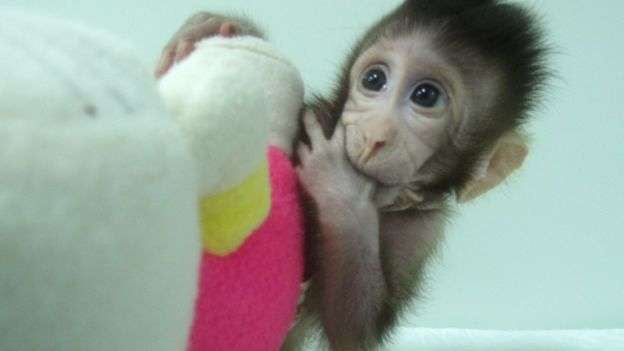【BBC】首例体细胞克隆猴在中国诞生 [英国媒体]
这两只猴子的克隆使用了与克隆羊多利相同的技术。几周前,一模一样的长尾猴中中和华华在中国的一个实验室中诞生。一科学家说,基因相同的猴群可用于对人类的疾病研究。但批评者说,这项引起伦理关注的研究,使世界更加接近于克隆人类。
Two monkeys have been cloned using the technique that produced Dolly the sheep.
这两只猴子的克隆使用了与克隆羊多利相同的技术。
Identical long-tailed macaques Zhong Zhong and Hua Hua were born several weeks ago at a laboratory in China.
几周前,一模一样的长尾猴中中和华华在中国的一个实验室中诞生。
Scientists say populations of monkeys that are genetically identical will be useful for research into human diseases.
一科学家说,基因相同的猴群可用于对人类的疾病研究。
But critics say the work raises ethical concerns by bringing the world closer to human cloning.
但批评者说,这项引起伦理关注的研究,使世界更加接近于克隆人类。
Qiang Sun of the Chinese Academy of Sciences Institute of Neuroscience said the cloned monkeys will be useful as a model for studying diseases with a genetic basis, including some cancers, metabolic and immune disorders.
中国科学院神经科学研究所的孙强说,这些克隆猴可用于研究具有遗传基础的疾病模型,包括一些癌症,代谢和免疫疾病。
"There are a lot of questions about primate biology that can be studied by having this additional model," he said.
他说:“灵长类生物学有很多问题可以通过构建出一大批(具有完全相同遗传基因的)猴群来研究。
Zhong Zhong was born eight weeks ago and Hua Hua six weeks ago. They are named after the Mandarin term for the Chinese nation and people.
中中八周前出生,华华六周前出生,他们以中华民族的名字命名。
The researchers say the monkeys are being bottle fed and are currently growing normally. They expect more macaque clones to be born over the coming months.
研究人员说,这些猴子还在吃奶,目前生长正常。他们预计未来几个月会诞生更多的克隆猴。
'Not a stepping stone'
“不是垫脚石”
Prof Robin Lovell-Badge of The Francis Crick Institute, London, said the technique used to clone Zhong Zhong and Hua Hua remains "a very inefficient and hazardous procedure".
伦敦弗朗西斯·克里克研究所的罗宾·洛弗尔教授说,用于克隆中中和华华的技术仍然是“一个非常低效和危险的过程”。
"The work in this paper is not a stepping-stone to establishing methods for obtaining live born human clones," he said.
他说:“这项研究工作不是建立获取活人克隆技术的垫脚石。
Prof Darren Griffin of the University of Kent said the approach may be useful in understanding human diseases, but raised ethical concerns.
肯特大学的达伦·格里芬教授表示,这种方法可能对理解人类疾病有用,但会引起道德问题。
"Careful consideration now needs to be given to the ethical framework under which such experiments can, and should, operate," he said.
他说:“现在需要认真地考虑这种实验可以并且应该进行的道德框架。
Dolly made history 20 years ago after being cloned at the Roslin Institute in Edinburgh. It was the first time scientists had been able to clone a mammal from an adult cell, taken from the udder.
20年前,在爱丁堡的罗斯林学院克隆产生的多莉,创造了历史。这是科学家第一次从乳房中取出的体细胞成功克隆的哺乳动物。
Since then many other mammals have been cloned using the same somatic cell nuclear transfer technique (SCNT), including cattle, pigs, dogs, cats, mice and rats.
此后,许多其他哺乳动物已经使用相同的体细胞核移植技术(SCNT)被克隆出来,包括牛,猪,狗,猫,小鼠和大鼠。
This involves transferring DNA from the nucleus of a cell to a donated egg cell, which has had its own DNA removed. This is then prompted to develop into an embryo and implanted in a surrogate animal.
这个技术包括将DNA从细胞核转移到已经除去了细胞核的卵细胞,然后促使其发育成胚胎并植入替代动物中。
Zhong Zhong and Hua Hua are the first non-human primates cloned through this technique.
中中和华华是通过这种技术克隆的第一批非人类灵长类动物。
In 1999, a rhesus monkey embryo was split in two in order to create two identical twins. One of the baby monkeys born through that technique - called Tetra - has the title of the world's first cloned monkey, but it did not involve the complex process of DNA transfer.
1999年,一只恒河猴胚胎被分成两部分,用来创造两个同卵双胞胎。通过这种技术诞生的小猴子之一 - Tetra-拥有世界上第一只克隆猴的头衔,但它并不涉及DNA转移的复杂过程。
'Much failure'
“(经历了)很多失败”
In the study, published in the journal Cell, scientists used DNA from foetal cells.
在《细胞》杂志上发表的这项研究中,科学家使用了来自胎儿细胞的DNA。
After the DNA was transferred to donated eggs, genetic reprogramming was used to alter genes that would otherwise have stopped the embryo developing.
在将DNA转移到卵子中后,使用遗传编程技术来改变本来会阻止胚胎发育的基因。
Zhong Zhong and Hua Hua were the result of 79 attempts. Two other monkeys were initially cloned from a different type of cell, but failed to survive.
中中和华华是79次尝试的结果。还有另外两只猴子最初是从不同类型的细胞中克隆出来的,但是没能活下来。
Dr Sun said: "We tried several different methods, but only one worked. There was much failure before we found a way to successfully clone a monkey."
孙博士说:“我们尝试了好几种不同的方法,但只有一种方法奏效,在找到成功克隆猴子的方法之前,还有很多失败。
The scientists say they followed strict international guidelines for animal research, set by the US National Institutes of Health.
科学家说,他们遵循严格的国际动物研究指导方针,这是由美国国立卫生研究院制定的。
Co-researcher Dr Muming Poo, also of the Chinese Academy of Sciences in Shanghai, said: "We are very aware that future research using non-human primates anywhere in the world depends on scientists following very strict ethical standards."
中国科学院上海合作研究员慕明博士说:“我们非常清楚,未来在世界上任何地方使用非人类灵长类动物的研究都需要科学家遵循非常严格的道德标准。”
版权声明
我们致力于传递世界各地老百姓最真实、最直接、最详尽的对中国的看法
【版权与免责声明】如发现内容存在版权问题,烦请提供相关信息发邮件,
我们将及时沟通与处理。本站内容除非来源注明五毛网,否则均为网友转载,涉及言论、版权与本站无关。
本文仅代表作者观点,不代表本站立场。
本文来自网络,如有侵权及时联系本网站。
图文文章RECOMMEND
热门文章HOT NEWS
-
1
最近,新冠肺炎疫情在日本有扩大的趋势,有专家呼吁日本应当举国行动起来,共...
- 2
- 3
- 4
- 5
- 6
- 7
- 8
- 9
- 10
推荐文章HOT NEWS
-
1
最近,新冠肺炎疫情在日本有扩大的趋势,有专家呼吁日本应当举国行动起来,共...
- 2
- 3
- 4
- 5
- 6
- 7
- 8
- 9
- 10














